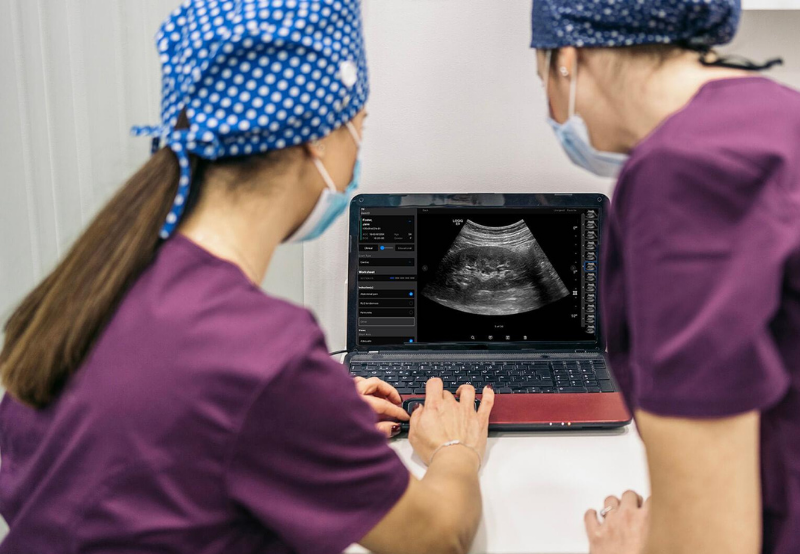Press Release
Exo Raises $220 Million As Hand-Held Ultrasound Race Heats Up

As the race to be the first to provide hand-held ultrasound heating up, Exo has come out on top with its latest investment round of $220 million. We’ll examine what this means for the industry and how this could benefit healthcare providers and patients alike.
The Growing Trend of Handheld Ultrasound Devices
The use of handheld ultrasound devices is becoming more and more common among medical professionals. There are many reasons for this growing trend. First, handheld ultrasound devices are becoming more and more affordable. Second, they are much easier to use than traditional ultrasound machines. Third, the quality of the images produced by handheld ultrasound devices is improving all the time.
There are many different types of handheld ultrasound devices on the market today. Some of the most popular brands include the SonoSite M-Turbo, GE Vscan, Philips CX50, and Toshiba Nemio. Each of these brands has its own strengths and weaknesses. However, all of them offer a great way for medical professionals to get high-quality images without having to lug around a full-sized ultrasound machine.
One of the biggest advantages of handheld ultrasound devices is that they are much cheaper than traditional ultrasound machines. The SonoSite M-Turbo, for example, costs around $30,000. That may seem like a lot of money, but it’s actually very affordable when you compare it to the cost of a traditional machine, which can easily run into the hundreds of thousands of dollars.
Another big advantage of handheld ultrasound devices is that they are much easier to use than their larger counterparts. Most models only require one person to operate them, which makes them ideal for busy medical practices. Additionally, many models come with built-in software that makes it easy to get high-quality images without any
Changing Trends in Handheld Ultrasound Devices
The popularity of handheld ultrasound devices has grown in recent years, as has the number of companies producing them. Exo, a startup that makes a hand-held ultrasound device, has raised $8 million in funding to help it compete in this rapidly growing market.
Handheld ultrasound devices are becoming increasingly popular due to their portability and affordability. Their small size means they can be easily carried around and used in a variety of settings, including primary care offices, urgent care clinics, and even at home.
Their affordability is also making them more popular. Prices for handheld ultrasound devices have come down significantly in recent years, making them more accessible to a wider range of users.
Exo’s device is called the OmniScan, and it’s designed to be used by both medical professionals and consumers. The company plans to use the funding to further develop its product and expand its marketing efforts.
With more companies entering the market and competition increasing, prices for handheld ultrasound devices are likely to continue to fall. This will make them even more popular and allow more people to benefit from their use.
Exo Aipowered 220m $220 million
In May 2014, Exo raised $220 million in a Series B round of funding led by Kleiner Perkins Caufield & Byers. The company has now raised a total of $340 million.
Exo is developing a hand-held ultrasound device that it says will be much cheaper and easier to use than current devices on the market. The company was founded in 2012 by Mehmet Yigit (CEO) and Miki Kuwabara (COO), who met while working at getUWired, a web design company.
The funding will be used to continue developing the product, as well as to expand the team and build out the sales and marketing infrastructure. Exo is currently available for pre-order, with shipping expected to begin in late 2014 or early 2015.
What are Some of the Main Features of Exo’s Device?
Some of the main features of Exo’s device include its portability, affordability, and accuracy. The device is about the size of a smartphone and can be easily carried in a pocket or purse. It uses sensors to detect sound waves and then sends the data to an app on a connected device, such as a smartphone or tablet. The app then displays the images on a screen for the user to see.
The device is said to be much more affordable than traditional ultrasound machines, which can cost tens of thousands of dollars. Exo plans to sell its devices for around $2,000. The company says that its technology is also more accurate than other portable ultrasound devices on the market.
How to Navigate Challenges Faced by Handheld Ultrasound User?
There is no question that handheld ultrasound devices have revolutionized medical care. But as with any new technology, there are challenges that need to be addressed. Here are some tips on how to navigate the challenges faced by handheld ultrasound users:
1. Make sure you have a good understanding of the anatomy and physiology of the body part you are scanning. This will help you to better identify abnormalities and avoid potential errors.
2. Be aware of potential artifacts that can occur during scanning. These can include shadowing, reverberation, and side lobe artifacts.
3. Use patient positioning techniques to optimize image quality. This includes using proper bedding, pillows, and positioning pads.
4. Understand the limitations of your device. Do not attempt to scan beyond the capabilities of your machine or software application.
5. Stay up-to-date on advances in technology and software updates. This will help you make the most of your device and ensure that you are using it in the most effective way possible
RIS Review
Exo is on a mission to make ultrasound more accessible, affordable, and portable. The company has raised $10 million in seed funding to bring its hand-held ultrasound device to market.
The Exo ultrasound is designed for use in primary care settings and is FDA cleared for 13 applications including abdominal, cardiac, and obstetric imaging. The device has a suggested retail price of $9,995 and will be available in the US later this year.
The Exo ultrasound is unique in its design and pricing, but it’s not the only player in the hand-held ultrasound market. SonoSite, GE Healthcare, Philips Healthcare, and Siemens Healthineers all offer handheld ultrasounds that range in price from $5,000 to $20,000.
The hand-held ultrasound market is growing as demand increases for point-of-care diagnostic tools. This type of ultrasound can be used to quickly and easily diagnose a variety of conditions without the need for a traditional cart-based system.
With its competitive pricing and easy-to-use design, the Exo ultrasound has the potential to disrupt the hand-held ultrasound market.
Press Release
Sang Sultantoto

If you’re trying to find Moenime Then, this is where you can locate several sources that provide in-depth information.
BANDAR TOGEL – TOGEL ONLINE HONGKONG, SULTANTOTO
To those who play togel, particularly those who play togel in Hong Kong, this statement applies: TOGEL ONLINE INDONESIA & BANDAR TOGEL HONGKONG. Togel is a very popular game in Indonesia and is played frequently. SULTANTOTO was established to give you the time and space to play Hong Kong togel and handle payments.
https://sangsultan.asia/
BANDAR TOGEL – TOGEL ONLINE HONGKONG, SULTANTOTO
Sultantoto bandar SGP, which emerged in recent years and now serves as a togel marketplace for all Indonesian online togel players, makes it easier for players to engage in togel play wherever they may be.
https://sangsultan.asia/wap
Bandar Togel Online Direkturtoto Penyedia DIREKTUR TOTO
Link Alternate: https://rebrand.ly/direkturtoto01 | https://rebrand.ly/direkturtoto02 | Bandar Togel Singapore dan Togel Hongkong Versi Togel WAP
https://sangdirektur.co/wap/permainan/play.html?
loc=gvszgvt7
I hope the materials mentioned above are useful in providing you with knowledge about sung sultantoto. If not, you can contact me through the comments.
Press Release
Critical GitLab flaw permits account takeover by attackers

GitLab has patched a critical severity flaw that may have let remote attackers exploit hardcoded passwords to seize control of user accounts.
Both the Community Edition (CE) and Enterprise Edition of GitLab are impacted by the flaw, which was identified internally and is designated CVE-2022-1162 (EE).
During OmniAuth-based registration in GitLab CE/EE, static passwords were unintentionally set, which led to this vulnerability.
In a security advisory released on Thursday, the GitLab team stated that “a hardcoded password was set for accounts registered using an OmniAuth provider (e.g. OAuth, LDAP, SAML) in GitLab CE/EE versions 14.7 prior to 14.7.7, 14.8 prior to 14.8.5, and 14.9 prior to 14.9.2 allowing attackers to potentially take over accounts.”
In order to thwart such assaults, GitLab strongly advised users to update all GitLab installations right away to the most recent versions (14.9.2, 14.8.5, or 14.7.7).
We STRONGLY RECOMMEND UPGRADING TO THE LATEST VERSION AS SOON AS POSSIBLE FOR ALL INSTALLATIONS RUNNING A VERSION AFFECTED BY THE ISSUES DESCRIB
A code patch made two days ago reveals that GitLab removed the ‘lib/gitlab/password.rb’ file, which was used to give the ‘TEST DEFAULT’ constant a shoddy hardcoded password.
Some GitLab users had their passwords reset.
GitLab also stated that as part of the CVE-2022-1162 mitigation effort, it reset a select few GitLab.com users’ passwords.
Additionally, it did not discover any proof that any accounts had been compromised by hackers exploiting the hardcoded password security weakness.
As of 15:38 UTC, “We completed a reset of GitLab.com passwords for a chosen selection of users,” the GitLab staff stated.
Although there is no evidence to suggest that users’ or accounts’ security has been compromised, we are nonetheless taking precautions for our users’ safety.
A GitLab representative provided the information already included in the advisory with BleepingComputer when asked how many Gitlab.com users had their passwords reset, adding that they only did it for “a selected set of people.”
A programme to recognise affected user accounts
GitLab has developed a script that self-managed instance administrators can use to find user accounts that might be affected by CVE-2022-1162, despite the fact that the firm claims no user accounts have been compromised so far.
Administrators are urged to reset the users’ passwords after identifying any user accounts that might have been impacted.
GitLab claims that over 100,000 businesses utilise its DevOps platform, and it has over 30 million estimated registered users from 66 different nations.
Press Release
CCPA NEEDS STRONGER ENFORCEMENT, BUT “AUTHORIZED AGENTS” LIKE DONOTPAY CAN MAKE IT EASIER FOR CONSUMERS TO OPT OUT OF DATA COLLECTION (KAVEH WADDELL/CONSUMER REPORTS).

Understanding the five major aspects of HRM — Employees are not just part of your organization, they are your organization. To keep your business running smoothly, employees have to be managed efficiently and their needs have to be catered to.
-

 Apps1 year ago
Apps1 year agoWhy is Everyone Talking About Hindi Keyboards?
-

 Social Media1 year ago
Social Media1 year agoWho is Rouba Saadeh?
-

 Apps1 year ago
Apps1 year agoThings you need to know about Marathi keyboard today
-

 Apps1 year ago
Apps1 year agoStuck with Your default Bangla keyboard? Isn’t it time for a change?
-

 Games1 year ago
Games1 year agoTop 7 Popular Puzzle and Card Games for Relaxing Your Brain on Mobile, Featuring Solitaire
-

 Social Media1 year ago
Social Media1 year agoMati Marroni Instagram Wiki (Model’s Age, Net Worth, Body Measurements, Marriage)
-

 Entertainment1 year ago
Entertainment1 year ago12 Online Streaming Sites that Serve as Best Alternatives to CouchTuner
-

 Entertainment1 year ago
Entertainment1 year agoMovierulz Website: Movierulzz 2021 Latest Movies on Movierulz.com
